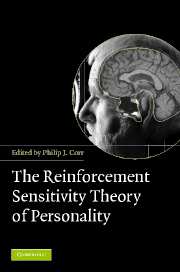Book contents
- Frontmatter
- Contents
- List of abbreviations
- List of figures
- List of tables
- List of contributors
- Preface
- 1 Reinforcement Sensitivity Theory (RST): introduction
- 2 The neuropsychology of fear and anxiety: a foundation for Reinforcement Sensitivity Theory
- 3 Animal cognition and human personality
- 4 The behavioural activation system: challenges and opportunities
- 5 Reinforcement Sensitivity Theory and personality
- 6 Reinforcement sensitivity scales
- 7 Performance and conditioning studies
- 8 Psychophysiological studies
- 9 Reinforcement Sensitivity Theory and mood induction studies
- 10 Neuro-imaging and genetics
- 11 Reinforcement Sensitivity Theory and psychosomatic medicine
- 12 RST and clinical disorders: anxiety and depression
- 13 RST and psychopathy: associations between psychopathy and the behavioral activation and inhibition systems
- 14 Behavioural activation and inhibition in social adjustment
- 15 Reinforcement sensitivity in the workplace: BIS/BAS in business
- 16 Formal and computational models of Reinforcement Sensitivity Theory
- 17 Reinforcement Sensitivity Theory: a critique from cognitive science
- 18 The contribution of Reinforcement Sensitivity Theory to personality theory
- General Index
- Index of Names
- References
14 - Behavioural activation and inhibition in social adjustment
Published online by Cambridge University Press: 31 January 2011
- Frontmatter
- Contents
- List of abbreviations
- List of figures
- List of tables
- List of contributors
- Preface
- 1 Reinforcement Sensitivity Theory (RST): introduction
- 2 The neuropsychology of fear and anxiety: a foundation for Reinforcement Sensitivity Theory
- 3 Animal cognition and human personality
- 4 The behavioural activation system: challenges and opportunities
- 5 Reinforcement Sensitivity Theory and personality
- 6 Reinforcement sensitivity scales
- 7 Performance and conditioning studies
- 8 Psychophysiological studies
- 9 Reinforcement Sensitivity Theory and mood induction studies
- 10 Neuro-imaging and genetics
- 11 Reinforcement Sensitivity Theory and psychosomatic medicine
- 12 RST and clinical disorders: anxiety and depression
- 13 RST and psychopathy: associations between psychopathy and the behavioral activation and inhibition systems
- 14 Behavioural activation and inhibition in social adjustment
- 15 Reinforcement sensitivity in the workplace: BIS/BAS in business
- 16 Formal and computational models of Reinforcement Sensitivity Theory
- 17 Reinforcement Sensitivity Theory: a critique from cognitive science
- 18 The contribution of Reinforcement Sensitivity Theory to personality theory
- General Index
- Index of Names
- References
Summary
Gray's theory, now known as Reinforcement Sensitivity Theory (RST), describes three major neuropsychological systems, the Behavioural Inhibition System (BIS), the Behavioural Activation System (BAS) and the Fight-Flight System (FFS). In psychometric and experimental studies, only two of these have received confirmation. In particular, psychometric evidence does not support the existence of FFS as a unified dimension orthogonal to BIS and BAS (Wilson, Gray and Barrett 1990; Wilson, Barrett and Iwawaki 1995; Slobodskaya et al. 2001; Knyazev, Slobodskaya and Wilson 2004). This chapter will therefore concentrate upon the BIS and BAS dimensions. First, we comment on the position of BIS and BAS within the hierarchy of personality and temperament traits. Then we consider certain difficulties linked with research on the social implications of RST and summarize empirical evidence linking BIS and BAS with social adjustment. Finally, we offer an interpretation of this data and review scarce evidence regarding the moderating role of environmental factors and cognitive abilities on the relationship between BAS, BIS and social outcomes.
BAS, BIS and hierarchical models of personality and temperament
To a large extent, BAS and BIS could be viewed as the two highest-order dimensions of personality. Following the ‘Big Five’ and Eysenck's ‘Giant Three’, we might perhaps dub these the ‘Gargantuan Two’. CFA studies of the Eysenck Personality Profiler usually find negative correlations between the Extraversion and Neuroticism factors (Eysenck, Wilson and Jackson 2000; Moosbrugger and Fischbach 2002; Knyazev, Belopolsky, Bodunov and Wilson 2004).
- Type
- Chapter
- Information
- The Reinforcement Sensitivity Theory of Personality , pp. 415 - 430Publisher: Cambridge University PressPrint publication year: 2008
References
- 2
- Cited by



